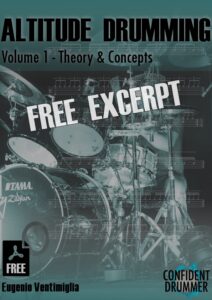Who said that drummers don’t need to know any theory to play?
I’m not talking about studying pentatonic scales and the circle of fifths here, although that wouldn’t hurt.
I have met so many drummers who regret not having learned how to read music, count, write and understand the theory involved in playing our instrument.
As much a I love banging on the drums or checking out the latest cool lick, over the years I have discovered that having the theory down can save us a lot of headaches, frustrations and even wasted opportunities.
Drum theory is a topic of absolute importance for every drummer, since it sets the foundation for everything we practice (and play) and having zero knowledge of it prevents us from actually understanding what we are doing.
However, studying this area of drumming can be tricky, due to the many topics, concepts and techniques involved, which are all linked to each other and yet rarely explained thoroughly.
Since my approach when writing a book is always to create tools to help drummers avoid the hassle I had to go through, I have tried to organize the materials collected over many years in a clear, comprehensive manual.
The end result is a method that covers all theory and concepts necessary to play like a pro, from the simplest notions to the most advanced ones.
The book is arranged in practical chapters, one for each main topic. You will be guided step by step through a modern and effective program, while exploring interesting and musical applications:
- Time Signatures, Notes, Music Notation and Note Values.
- Subdivisions and Subdivisions Combinations, including Quintuplets, Sextuplet, Septuplets and Ninetuplets.
- Note Groupings and Odd Groupings.
- Counting Techniques.
- Binary and Ternary Rhythmic Figures.
- Solfeggio, Reading and Music Interpretation.
- Hearing Complex Rhythms.
- Odd Times.
- Rhythmic Illusions.
- Rhythmic Displacement (Permutations).
- Polyrhythms.
- Metric Modulation.
- Dynamics, Crescendo and Decrescendo.
- Shuffle Feel Interpretation and Inverted Shuffle Feel.
- Micro Rhythms.
- Swing Levels, Normal and Inverted.
- Timing: Playing on the Beat, Ahead or Behind.
- Time Morphing.
- Swag Drumming or Drunk Feel (J Dilla Style).
- Song Form and Structures.
- Active Listening and Recommended Listenings.
- Transcribing Music.
- Posture and Breathing.
In total it’s more than 140 pages and 90 minutes of videos, in which you are going to learn all the concepts you need to clear up any confusion about drum theory.
It’s cool to have it all organized, so that you can use it to work on subjects you never studied or to revisit ideas you haven’t gone through in a while.
In this free excerpt I’d like to share with you 30 examples picked from the 200+ studies included in the method. I wanted to arrange this booklet so that it’s like a mini course, that you can use to instantly improve your understanding of drum theory, while also seeing firsthand how important it is to have this stuff down.
You can download it here:
The transcription of all exercises, as well as the table of contents of the method, is included in this 16 page PDF. Each example is linked to its video demo, which you can access by clicking on the transcription.
If you want to check out the whole 10 minute video demo on YouTube, click HERE.
To find out more and to buy the method you can visit the dedicated page here:
‘Theory & Concepts’ – Altitude Drumming – Volume 1



















